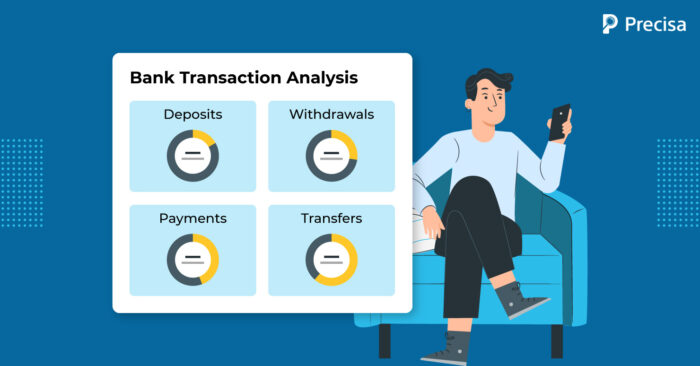Enhancing Customer Experience with Personalised Bank Transaction Analysis

Offering outstanding customer service is crucial for financial institutions to stay ahead in today’s competitive banking environment. A Business Wire study notes that 72% of customers seek personalised services. Therefore, banks have to seek creative approaches to satisfy their demands constantly. One such strategy is using innovative technologies like bank transaction analysis to improve customer experience. Banks may offer customised insights and suggestions based on specific financial transactions by leveraging the power of data analytics.
In this blog, we explore bank transaction analysis and how it can deliver a distinguished customer experience to satisfy demand.
Understanding Bank Transaction Analysis
Bank transaction analysis generally entails comprehensively examining and understanding a customer’s deposits, withdrawals, payments, and transfers. Customers often monitor their bank statements to keep track of their expenses, but personalised analysis goes beyond.
According to a survey by Forrester Consulting, 73% of customers are more inclined to remain with a bank that offers personalised services based on their financial goals and preferences.
Using machine learning (ML) algorithms and artificial intelligence (AI), banks may analyse transactional data in real-time to get important insights about individual spending patterns, financial objectives, and trends.
7 Key Benefits of Personalised Banking Statement Analysis
Understanding and managing financial transactions may become more accessible with bank transaction analysis. This strategy allows individuals to get insightful information and make wise financial decisions.
Here are a few significant benefits:
1. Tailored Financial Recommendations
Accenture research revealed that 83% of banking customers want their bank to understand their unique needs and offer personalised guidance based on their financial behaviours.
Banks may get a comprehensive picture of each customer’s spending habits, financial aspirations, and spending trends by carefully examining their bank statements. Using this data, a broad range of beneficial suggestions may be made on a range of financial services and products, including investment opportunities, credit cards, loans, insurance policies, etc.
For instance, if a customer often spends money on travel-related costs, the bank may provide travel rewards credit cards or propose appropriate vacation savings plans, thereby making pertinent suggestions that are tailored to the customer’s particular requirements.
2. Enhanced Financial Awareness
Using personalised analysis, customers can better understand their financial situation by classifying transactions and using visual representations, such as graphs and charts and graphs. Customers can quickly find out their spending habits, budgeting possibilities, and areas for possible savings. This enhanced information encourages fiscal responsibility and empowers customers to make wise choices.
Bank transaction analysis assists customers in tracking their progress toward financial goals and having a comprehensive picture of their financial status. Additionally, personalised insights and visualisations may streamline account management, enabling customers to monitor and manage their accounts in a single location effortlessly.
3. Proactive Financial Risk Management
Personalised bank statement analysis plays a vital role in detecting and preventing fraudulent activities. By tracking patterns and identifying oddities in transaction data, banks can recognise early warning signs of fraudulent activities or unauthorised transactions, alerting customers promptly.
Banks can boost their security procedures and minimise financial losses for customers by taking a proactive approach. This results in elevated consumer confidence, providing a safe banking experience and improving the customer experience by providing effective fraud detection through personalised bank statement analysis.
This proactive strategy shields customers from monetary losses and builds their confidence in the bank’s security protocols, enhancing their overall experience.
4. Budgeting and Financial Planning
Many customers find it difficult to manage their finances and set budgets successfully. Banks can give useful insights into a customer’s spending patterns and personalised budgeting guidance bank transaction analysis.
Banks can make customised recommendations and constructive ideas to boost their customers’ financial well-being by comprehending each customer’s spending habits and financial objectives. For instance, the bank can recommend budgeting techniques or loyalty programs that give meal discounts if customers often dine out and spend much of their income on restaurants.
Customers can also get tailored advice based on their financial profile on how to save money, pay off debt, or maximise their investments. Customers who receive this personalised financial guidance can make wiser decisions, accomplish their objectives, and ultimately improve their overall financial well-being and happiness with the bank’s services.
5. Targeted Market Campaigns
Using a personal bank statement analysis, banks may better understand the preferences and actions of their customer base. Using this information, tailored advertising techniques that appeal to certain customers can be designed.
Banks could significantly enhance the efficacy of their marketing campaigns and boost response rates and customer engagement by providing relevant offers and promotions personalised to each customer’s needs and preferences.
6. Enhanced Customer Support
Analysing bank data can also enable customer service representatives to offer more specialised support. With thorough knowledge of a customer’s financial activities, customer care personnel can respond to specific issues and offer unique solutions quickly and precisely.
This personalised approach to customer service indicates the bank’s dedication to understanding and helping its customers, which fosters higher client retention and satisfaction.
7. Customised Financial Notifications and Alerts
Financial notifications and alerts that are specifically tailored to each customer’s needs can be sent by banks using information from their customers’ personalised bank statements. Banks can identify and proactively advise customers about important occurrences like low balance alerts, bill payment reminders, approaching loan or credit card payment due dates, or account overdraft warnings by tracking transaction data.
Customers can better manage their financial commitments, stay informed, and avoid unnecessary penalties and fees due to these timely and custom reminders. Ensuring customer satisfaction by offering pertinent and personalised notifications also helps promote smart financial management.
Conclusion
Personalised bank statement analysis has several advantages for both banks and their consumers. Banks can provide specific financial advice, proactively manage financial risks, help consumers with budgeting and financial planning, create focused marketing campaigns, and improve customer service by utilising customer transaction data.
These initiatives improve the general customer experience and strengthen the bonds between banks and their customers, thereby boosting customer loyalty and retention rates.
Therefore, an effective way for banks to stand out in an increasingly competitive environment and position themselves as customers trusted financial partners is to embrace personalised bank statement analysis.
Precisa is the perfect bank transaction analysis software that empowers banks to leverage advanced data analytics, deliver personalised recommendations, enhance fraud detection, facilitate financial planning, drive customer engagement, and provide exceptional customer support.
With Precisa’s AI-powered capabilities, banks can optimise their services, improve customer experiences, and gain a competitive advantage in the banking industry.
Take the 14-day free trial and see the difference today!




